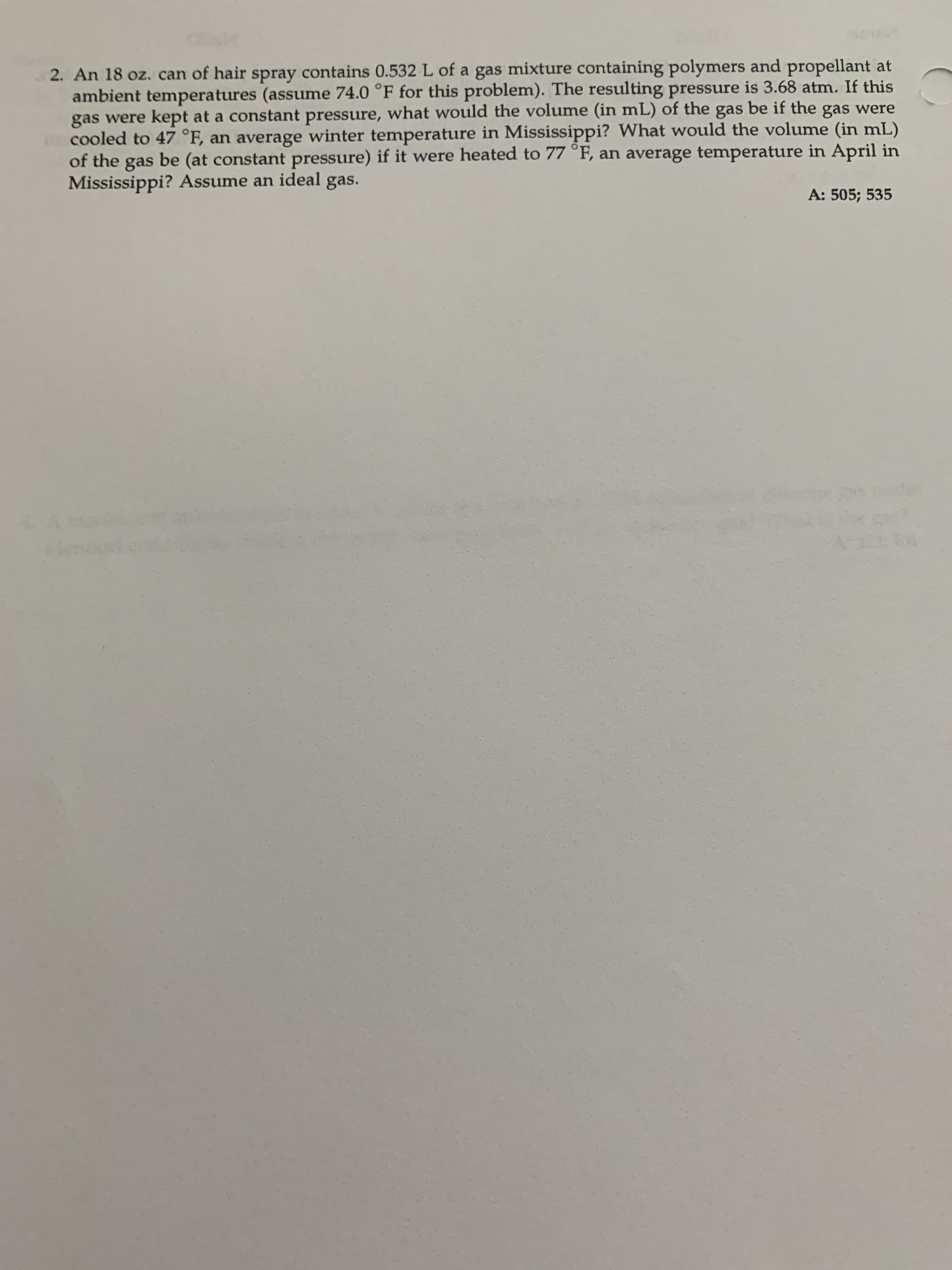2. An 18 oz. can of hair spray contains 0.532 L of a gas mixture containing polymers and propellant at ambient temperatures (assume 74.0 °F for this problem). The resulting pressure is 3.68 atm. If this gas were kept at a constant pressure, what would the volume (in mL) of the gas be if the gas were cooled to 47 °F, an average winter temperature in Mississippi? What would the volume (in mL) of the gas be (at constant pressure) if it were heated to 77 °F, an average temperature in April in Mississippi? Assume an ideal gas. A: 505; 535
2. An 18 oz. can of hair spray contains 0.532 L of a gas mixture containing polymers and propellant at ambient temperatures (assume 74.0 °F for this problem). The resulting pressure is 3.68 atm. If this gas were kept at a constant pressure, what would the volume (in mL) of the gas be if the gas were cooled to 47 °F, an average winter temperature in Mississippi? What would the volume (in mL) of the gas be (at constant pressure) if it were heated to 77 °F, an average temperature in April in Mississippi? Assume an ideal gas. A: 505; 535
Chemistry & Chemical Reactivity
10th Edition
ISBN:9781337399074
Author:John C. Kotz, Paul M. Treichel, John Townsend, David Treichel
Publisher:John C. Kotz, Paul M. Treichel, John Townsend, David Treichel
Chapter10: Gases And Their Properties
Section: Chapter Questions
Problem 103IL: Many nitrate salts can be decomposed by heating. For example, blue, anhydrous copper(II) nitrate...
Related questions
Question
2.

Transcribed Image Text:2. An 18 oz. can of hair spray contains 0.532 L of a gas mixture containing polymers and propellant at
ambient temperatures (assume 74.0 °F for this problem). The resulting pressure is 3.68 atm. If this
gas were kept at a constant pressure, what would the volume (in mL) of the gas be if the gas were
cooled to 47 °F, an average winter temperature in Mississippi? What would the volume (in mL)
of the gas be (at constant pressure) if it were heated to 77 °F, an average temperature in April in
Mississippi? Assume an ideal gas.
A: 505; 535
Expert Solution
This question has been solved!
Explore an expertly crafted, step-by-step solution for a thorough understanding of key concepts.
This is a popular solution!
Trending now
This is a popular solution!
Step by step
Solved in 4 steps

Knowledge Booster
Learn more about
Need a deep-dive on the concept behind this application? Look no further. Learn more about this topic, chemistry and related others by exploring similar questions and additional content below.Recommended textbooks for you

Chemistry & Chemical Reactivity
Chemistry
ISBN:
9781337399074
Author:
John C. Kotz, Paul M. Treichel, John Townsend, David Treichel
Publisher:
Cengage Learning

Chemistry & Chemical Reactivity
Chemistry
ISBN:
9781133949640
Author:
John C. Kotz, Paul M. Treichel, John Townsend, David Treichel
Publisher:
Cengage Learning

Chemistry
Chemistry
ISBN:
9781305957404
Author:
Steven S. Zumdahl, Susan A. Zumdahl, Donald J. DeCoste
Publisher:
Cengage Learning

Chemistry & Chemical Reactivity
Chemistry
ISBN:
9781337399074
Author:
John C. Kotz, Paul M. Treichel, John Townsend, David Treichel
Publisher:
Cengage Learning

Chemistry & Chemical Reactivity
Chemistry
ISBN:
9781133949640
Author:
John C. Kotz, Paul M. Treichel, John Townsend, David Treichel
Publisher:
Cengage Learning

Chemistry
Chemistry
ISBN:
9781305957404
Author:
Steven S. Zumdahl, Susan A. Zumdahl, Donald J. DeCoste
Publisher:
Cengage Learning

Chemistry: An Atoms First Approach
Chemistry
ISBN:
9781305079243
Author:
Steven S. Zumdahl, Susan A. Zumdahl
Publisher:
Cengage Learning


General Chemistry - Standalone book (MindTap Cour…
Chemistry
ISBN:
9781305580343
Author:
Steven D. Gammon, Ebbing, Darrell Ebbing, Steven D., Darrell; Gammon, Darrell Ebbing; Steven D. Gammon, Darrell D.; Gammon, Ebbing; Steven D. Gammon; Darrell
Publisher:
Cengage Learning